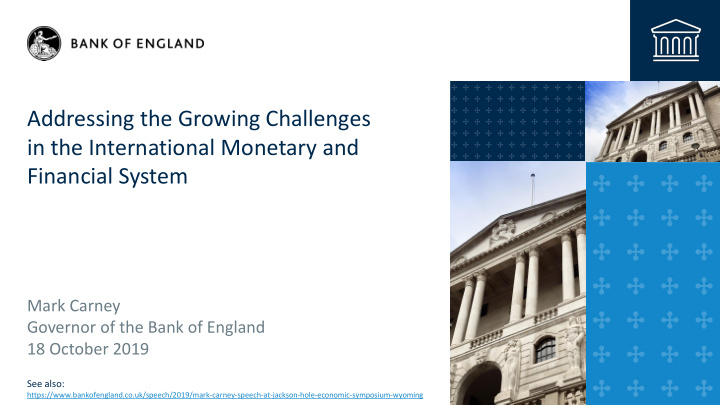



Addressing the Growing Challenges in the International Monetary and Financial System Mark Carney Governor of the Bank of England 18 October 2019 See also: https://www.bankofengland.co.uk/speech/2019/mark-carney-speech-at-jackson-hole-economic-symposium-wyoming
Asymmetry at heart of IMFS is growing …yet network effects mean US $ dominates international trade and finance US share of global economy shrinking… • US developments have large spillovers, even for countries with limited direct exposure 2
For EMEs, US $ dominance reduces sustainable capital flows Number % of GDP 6 6 Net private capital flows to EMEs (lhs) Number of EME crises 5 (rhs) 5 4 4 3 3 2 2 1 1 0 -1 0 1980 1985 1990 1995 2000 2005 2010 2015 • Capital flow volatility reduces potential growth and increases risk of crises, encouraging EMEs to accumulate costly reserves as insurance 3
A holistic Capital Flows-at-Risk framework: Pull, Push, Pipes Pull factors Domestic institutional frameworks Push factors Determinants of global financial conditions Pipes Structure of the global financial system CAPITAL FLOWS-AT- RISK 4
Reforms to domestic institutional “pull factors” have substantially increased sustainable capital flows Probability density 0.12 2008-2018 0.10 0.08 Asian Financial Crisis 0.06 0.04 B A 0.02 0.00 -8 -6 -4 -2 0 2 4 6 8 10 12 14 16 18 Capital flows as a % of GDP 5
Push factors weighed more heavily over the past decade, offsetting some of the improvement in pull factors Probability density 0.12 2008-2018 0.10 0.08 Negative push shock 0.06 0.04 B C 0.02 0.00 -8 -6 -4 -2 0 2 4 6 8 10 12 14 16 18 Capital flows as a % of GDP 6
Structure of IMFS could overwhelm EMEs’ efforts to increase sustainable capital flows 2030 excluding growth 2030 including growth 2006 2018 2030a 2030b in EME external balance in EME external balance 1 sheets sheets -1 -2 Pre-crisis baseline -3 ∆ FX share Impact of a higher share of FX-denominated debt in EMs ∆ Flow composition Impact of the shift towards market-based finance ∆ Mutual funds Impact of the increasing role of investment funds -4 Total Total Capital Flows-at-Risk as a % of GDP 7
IMFS asymmetry increases risks of a global liquidity trap • IMFS structurally lowering global equilibrium interest rate, r*, by: - feeding a global savings glut: EMEs defensively accumulate reserves of safe US $ assets against backdrop of inadequate and fragmented global financial safety net; - lowering the rate of global potential growth due to less sustainable cross border flows; and - increasing the downside skew and fattening of the left-hand tail of likely economic outcomes. • Increasingly integrated world: global r* exerts greater influence on domestic r*. • Strains become more evident when – as recently – US conditions warrant tighter policy there than elsewhere. 8
What then can be done? 9
Short term : central banks must play hand they’ve been dealt UK monetary policy trade-offs in successive 3.0 Inflation (%) 3-year ahead Inflation Report projections August 2016 2.5 August 2017 Excess demand (%) 2.0 -1.0 -0.5 0.0 0.5 1.0 1.5 2.0 Excess supply (%) 1.5 Preferred trade-off if λ =0.1 Preferred trade-off if λ =1 1.0 • Use full flexibility in flexible inflation targeting 10
Short term: central banks must play hand they’ve been dealt Probability density 0.12 Tighter macro-prudential 0.10 stance 0.08 Average 0.06 macro-prudential stance B 0.04 A 0.02 0.00 -8 -6 -4 -2 0 2 4 6 8 10 12 14 16 18 Capital flows as a % of GDP • Macroprudential policy in EMEs can reduce Capital Flows-at-Risk 11
Medium term: reshuffle the deck – reform current IMFS Address pull factors in EMEs: Reinforcing monetary stability, including by safeguarding central bank EME independence Ensuring resilience of domestic financial sector Moderate push factors : Strengthen resilience of banks at the core of the global financial system Make sure investment funds prudently manage leverage and liquidity Fix the pipes of the global system: Reinforcing the Global Financial Safety Net, by ensuring that IMF resources are maintained Further improve IMF surveillance for analysing spillovers and traction to support coordinated actions 12
Long term: change the game – move to a multipolar system Benefits of multiple reserve currencies Diversification : the supply of safe assets increases, lowering the downward pressures on the global equilibrium interest rate Reduced spillovers from the core, including less synchronised trade and financial cycles Easier to manage coordination problems No illusions that IMFS can be reformed overnight - Network effects reinforce dominance of US $ - Transition to a new global reserve currency didn’t proceed smoothly in the past and may not in the future - Doesn’t make sense to swap one reserve currency for another; a multipolar world deserves multipolar system 13
Consider for long term: Synthetic Hegemonic Currency • Publicly issued basket of central bank digital currencies made widely available to settle payments and store value Central bank liabilities are safe, already widely-accepted means of payment Reliable, instantaneous, low cost domestic and international payments Addresses many of the shortcomings of private sector solutions SHC (privacy, treasury management, trust) Decision between wholesale (SDR) vs. retail (SHC) must be mindful that usage as medium of exchange has historically driven reserve currency adoption 14
Addressing the Growing Challenges in the International Monetary and Financial System Mark Carney Governor of the Bank of England 18 October 2019 See also: https://www.bankofengland.co.uk/speech/2019/mark-carney-speech-at-jackson-hole-economic-symposium-wyoming
Recommend
More recommend